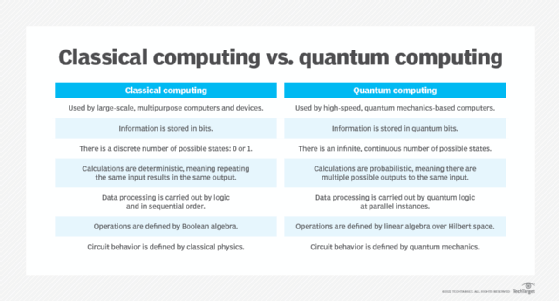What is Willow? Google's innovative quantum chip explained
Willow is a quantum computing chip developed by Google that was unveiled at the end of 2024. It can execute complex computations in minutes, whereas classical supercomputers would take 10 septillion years.
Google's Willow marked a milestone in the quantum computing field regarding speed and how it performs error correction techniques. It also proved that the error rates of a quantum computer can be reduced as more quantum bits, or qubits, are added, hinting that it might be possible to create larger quantum systems in the future that will perform more reliable computations.
Willow can perform quantum computations with significant improvements in error correction and stability using 105 qubits -- doubling its predecessor. This means that all the fields currently using quantum computing in limited areas, like drug discovery, will become more efficient and promising. Currently, Willow is primarily used by Google Quantum AI for research and development purposes.
How does the Willow quantum chip work?
In classical computing, information is conveyed physically by pulses of electrical voltage -- or light, when used in fiber-optic cables. These physical signals are represented digitally as binary bits of 1 or 0 values.
Quantum computing, however, uses the nature of subatomic particles to perform calculations. Instead of using binary bits, quantum computers use qubits. These use the same 1 and 0 bits as classical computing, but add a superposition state representing 0, 1 and any position in between.
Qubits run into a few real-world problems, however. For one, they are susceptible to noise -- anything that can cause an error, like environmental conditions or a wrongly applied operation -- and they can only maintain their quantum state for short periods.
The Willow quantum chip attempts to address these issues. For example, it uses transmon qubits, a specific type of qubit that reduces its sensitivity to noise, to perform quantum computations.
The logical qubits -- error-corrected qubits -- used in Willow are arranged in a seven-by-seven lattice, enabling a more scalable architecture for error correction. This lattice structure confirms that larger logical qubits can be more effective at preventing errors than smaller lattices.
Willow also improves the time a qubit can maintain its quantum state from 20 microseconds to 100 microseconds, enabling a quantum computer to run more complex problems.

Why is Google's Willow significant for quantum computing?
The Willow chip is significant for its breakthrough in error correction.
Today's quantum computers generally have a lot of noise that can cause errors. For example, modern quantum computers can suffer from the following:
- Qubit decoherence when qubits are affected by their environment.
- Gate errors when a quantum operation is applied to a qubit incorrectly.
- Measurement errors when a qubit in the right state is read wrong.
Quantum error correction tries to detect and fix errors as they occur. The process relies on redundancy to eliminate errors. In this strategy, single-qubit values are assigned to multiple qubits so that if even a few qubits encounter an error, the system should still be able to recognize and return accurate information.
The issue with this process is scalability. Typically, error correction only works reliably when it operates below a specific error threshold. If the qubits are too error-prone, adding more won't help. Willow demonstrates that increasing the size of error-corrected qubits can reduce the overall error rate. This brings the industry one step closer to creating larger, more fault-tolerant quantum computers.
What could Willow be used for?
Currently, there is no timeline for the broader commercial availability of Willow. However, its capabilities signal an increased value for use in areas where quantum computing typically excels. Quantum computing is well suited for anything requiring advanced simulations and complex problem-solving, including the following:
- AI.
- Cybersecurity.
- Drug discovery.
- Financial modeling.
- Materials sciences.
Due to cost and hardware limitations, it is not realistic for most organizations to own a quantum computer today. Instead, organizations can access a cloud-based service through a third party that provides quantum computing technology, called quantum as a service (QaaS). Willow is not currently available in a QaaS package, however.
Predecessors to the Willow chip
Willow builds on Google Quantum AI's previous quantum hardware, the Sycamore processor. In 2019, Google claimed that Sycamore had reached quantum supremacy -- a point at which a quantum device can solve a problem exponentially faster than a classical processor. Sycamore took about 200 seconds to sample one instance of a quantum circuit 1 million times, which would have taken a classical supercomputer nearly 10,000 years to do, according to Google. Sycamore had 53 physical qubits in comparison to Willow's 105.
In 2023, Google Quantum AI researchers demonstrated a logical qubit prototype. Both advancements were then applied to the creation of Willow.
What's next for quantum chip development?
Google is positioning Willow as a step toward developing a useful quantum computer with practical applications. Currently, Willow is advancing Google's quantum computing roadmap, pushing the field in a positive direction.
Google is not the only company advancing the field. Others, such as IBM, Intel, IonQ, Microsoft and Xanadu, are also developing quantum hardware that could propel the industry forward.
Willow could influence future chip designs and improvements in error correction as well.
Advancements in quantum computing also pose a growing threat to current encryption standards. Most modern encryption schemes rely on mathematical problems that classical computers cannot solve efficiently, but quantum computers have growing potential.
Shor's algorithm, for example, is a quantum algorithm capable of factoring large integers much faster than classical computing. As the quantum field advances, organizations should be better prepared to push for the adoption of post-quantum cryptography encryption standards.
The quantum computing field is making significant advancements thanks to developments like Willow. Learn more about other companies that are currently building quantum computers.







